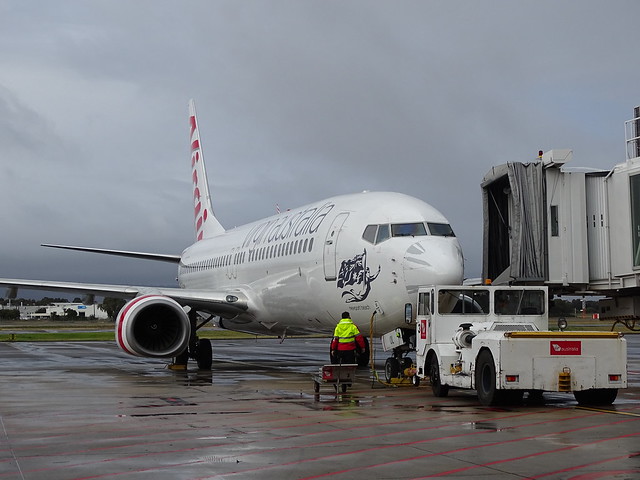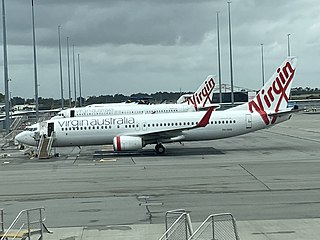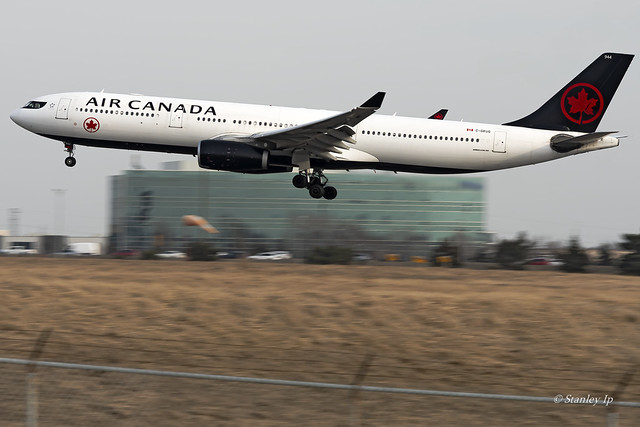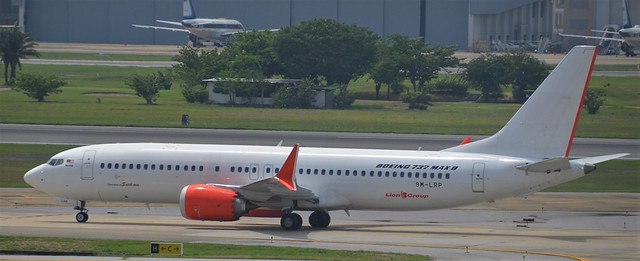Virgin Australia B738 at Adelaide on Apr 11th 2025, insufficient takeoff distance
Last Update: November 25, 2025 / 17:43:33 GMT/Zulu time
Incident Facts
Date of incident
Apr 11, 2025
Classification
Report
Airline
Virgin Australia
Flight number
VA-222
Departure
Adelaide, Australia
Destination
Melbourne, Australia
Aircraft Registration
VH-IHR
Aircraft Type
Boeing 737-800
ICAO Type Designator
B738
The ATSB released their final report into this and 2 other similiar occurrences concluding the probable cause of the total 14 incidents (11 without being listed and included) were:
Contributing factors
- The flight crews of multiple aircraft misidentified the start of runway 23 due to confusing temporary markings and lights. This resulted in several take-offs commencing from the displaced threshold using performance parameters for a longer runway.
- The Civil Aviation Safety Regulations Part 139 Manual of Standards did not recommend or provide standardised options for movement area guidance signs or other visual aids to draw flight crew attention to the start of take-off position, especially those distant from a displaced threshold and not coincident with a taxiway/runway intersection. (Safety issue)
- The initial NOTAM released at the start of the runway works used inconsistent terminology for the runway end, did not refer to the white line marking the start of take-off position, and referred to red runway end lights not visible to pilots departing on runway 23.
- For one of the reported occurrences, the aerodrome controller did not challenge 2 incorrect readbacks of displaced threshold instead of displaced runway end, which likely contributed to the flight crew commencing the take-off from the displaced threshold instead of the start of take-off position.
Other findings
- Proactive action taken by aircraft operators to highlight the start of take-off position and require use of performance data and/or take-off from the D1 intersection where possible, probably reduced the number of occurrences.
- Air traffic control interventions to mitigate the risk of pilot confusion likely reduced the number of occurrences.
The ATSB summarized the sequence of events (this being flight #2 of the report):
At 1309, from holding point B2, the PM contacted the ADC, advising that they were ready for take-off. The flight crew were then cleared to enter runway 23 at B2 and line up at the runway end, which the PM read back. The flight crew confirmed they were at B2, had selected the correct take-off data, and called ‘confirm data checked’, before they entered the runway. They received a take-off clearance one minute later.
The ADC then observed the aircraft continue taxiing beyond the start of the runway and stated, ‘Velocity 222 clear for take-off?’, which the PM read back. At the time, the PM assumed the controller had forgotten they had already issued the take-off clearance, but later reflected that this may have been a ‘subtle prompt’ to commence take-off.
The captain, who was the PF, reported that as they got to the runway start, they could see the green (threshold) lights in the distance and assumed that was where they were to commence the take-off. The captain observed that the aircraft lifted off further down the runway than expected, but assessed that the take-off was normal.
After departure, the flight crew reviewed the FCON and AIP SUP and realised that they had commenced the take-off from the incorrect position. The Virgin Australia safety department assessed that had the flight crew been required to reject the take-off just before V1, there may not have been adequate runway remaining to stop.
The ATSB further stated without listing the flights involved: "Two occurrences during daylight hours on 2 April, involving Virgin Australia and Qantas aircraft, were identified via FDAP. In both instances the aircraft commenced the take-off from the displaced threshold, while using performance data based on the SOT position."
The ATSB analysed:
From 31 March to 20 May 2025, taxiway construction works were carried out at Adelaide Airport, South Australia. To accommodate the works, the runway 23 start of take-off (SOT) position was temporarily displaced 650 m beyond the normal runway start, with the runway 23 landing threshold displaced a further 508 m beyond the temporary SOT position.
Subsequently, 13 occurrences were identified in which aircraft commenced the take-off from the displaced threshold, instead of the intended SOT position. As the flight crews had used take-off performance data based on commencing the take-off from the SOT position, this increased the risk of a runway overrun. The occurrences took place during both daylight and night-time hours, and involved several aircraft operators, with the first incident on 31 March 2025 and the last on 20 April 2025. Several more occurrences were prevented either by intervention from air traffic control (ATC), or by flight crews contacting ATC or their flight operations support personnel prior to departure to confirm the correct SOT position.
This analysis will discuss the effectiveness of the works information provided to flight crews, including aerodrome works lights and markings, and the required aerodrome standards. It will also review the contents of the NOTAM and its effectiveness in describing the SOT position. ATC phraseology will also be discussed, along with strategies used by controllers to assist pilots in identifying the SOT position. Finally, the Civil Aviation Safety Authority’s (CASA) review of the method of working plan and the timeliness of that review will be analysed.
Lights and markings confusion
The 2 flight crews interviewed by the ATSB had read the available documentation regarding the aerodrome works and received the automatic terminal information service (ATIS) prior to taxiing to depart from runway 23. They had also identified the works and displaced threshold as threats, and were aware there were different runway positions for landing and take-off. Additionally, they had landed on the runway less than 35 minutes earlier, having successfully identified the displaced threshold. The flight crews also noted a reminder in the operational documentation not to commence the take-off before passing the runway end.
However, having received clearance to enter the runway at the B2 holding point and taxi to the displaced runway end (SOT position), the flight crews did not identify the white line indicating the SOT position as stated in the revised NOTAM (and elsewhere). As it was a bright sunny day, they also did not see the start of red edge lights (specified to be visual cues for night and low visibility conditions), which commenced at the SOT position. As a result, the flight crew taxied to the displaced threshold before commencing the take-off.
In one of the incidents, this was also likely influenced by observing an aircraft ahead commence the take-off from the displaced threshold. The flight crews later realised the error and reported the occurrences.
For the 11 other occurrences, identified by aircraft operators’ analysis of their recorded flight data, it was unknown how much of the related documentation flight crews had been reviewed, or whether they were aware that the aircraft had departed from the incorrect position. As the ATIS did not contain any information relating to the SOT position, other than a difference between the stated take-off and landing distances, it did not offer a means to correct an incorrect understanding of its location.
Given the high number of occurrences, both day and night involving different aircraft operators, and the combined significant experience of the involved flight crews, the visual cues for the SOT position were almost certainly confusing.
By day, the white arrows and threshold lights were more prominent than the white runway end line designating the SOT position. However, there was no mention in the documentation of the white arrows, which pointed towards the displaced (landing) threshold. Flight crews found that these indicated to continue moving forwards before commencing take-off.
The red runway edge lights were illuminated day and night from 4 April 2025, but not readily visible in daylight. At night, the start of runway being a transition from green taxiway lighting to red edge lighting was insufficiently distinct. Additionally, being red as they were intended to indicate to pilots of landing aircraft not to land before the displaced threshold, the edge lights did not intuitively indicate the start position for take-off (or 'go').
The runway end line, while perceptible, did not identify the line as an indication of the start of runway position to many of the flight crew. It also had the same characteristics as the white displaced threshold line.
In addition to the reported occurrences and those identified by aircraft operators’ analysis of their flight data, many pilots queried ATC as to the correct SOT position, taxied very slowly to identify the SOT, and some were advised by ATC when they had missed the SOT and obtained clearances to re-taxi to the runway. Having observed aircraft pass the SOT position at slow speed, some controllers also reiterated the take-off clearance.
While well intended, it was ineffective at alerting crews that they had commenced the take-off beyond the position used for take-off performance calculations.
Although the Civil Aviation Safety Regulations Part 139 Manual of Standards (MOS) required movement area guidance signs (MAGS) showing the take-off run available from an intersection, this did not apply for a temporary SOT position that was not at a taxiway or runway intersection.
In the absence of any signage, holding point or runway/taxiway intersection at the SOT, there was no reference for flight crews to crosscheck the aircraft’s position before commencing the take-off, in accordance with standard operating procedures. To mitigate this absence of MAGS during aerodrome works with reduced runway length, based on research conducted by the Airport Construction Advisory Council, the United States Federal Aviation Administration (FAA) introduced black and orange construction signage, one of which stated the take-off run available from the SOT position.
The ineffective visual cues resulted in multiple take-offs from the displaced threshold instead of runway start by flight crew. These resulted in reduced safety margins and increased the risk of a runway overrun. In at least 3 of these occurrences, there would likely have been insufficient runway remaining had the flight crew been required to reject the take-off near the decision speed (V1).
...
NOTAM clarity
The initial NOTAM released at the start of the runway works (and repeated in the Aeronautical Information Publication Supplement (AIP SUP) stated that the ‘Runway 23 displaced runway end will be marked with 3 red lights each side of runway 23’. This was referring to what is defined as the reciprocal (05) runway end, not the collocated SOT position. While the AIP included the abbreviation ‘SOT’ as the start of take-off run available (TORA) position, it was not well known, nor an international standard.
Being unidirectional, the red runway end lights were visible to aircraft landing on runway 05, but not visible to aircraft departing on runway 23. As such, the initial NOTAM wording did not assist clear identification of the SOT position for runway 23 and used inconsistent terminology for the runway end. Recognising that the NOTAM was not the sole source of information, it probably contributed to flight crew confusion and the subsequent occurrences.
The NOTAM text was included in the method of working plan (MOWP) and referred to the MOWP for more detailed information. The AIP SUP was published as required for more complex information. Although one reference to the runway 23 end was amended to the runway 23 SOT in the AIP SUP and MOWP before works commenced, that was not reflected in the NOTAM until after the works commenced and pilot confusion had occurred. The amended version of the NOTAM gave the white line and red edge lights as cues for the start of take-off, but it was not sufficient to prevent further occurrences.
In general, NOTAMs present summary abbreviated information and do not distinguish between operationally critical and less relevant information for flight crew. The works NOTAM had typical limitations including a large block of capitalised text with no prioritisation of key information and no obvious way to identify key information for aircraft departing on runway 23.
Air traffic control phraseology and intervention
Prior to commencement of the works, based on the information provided by AAL, Adelaide Tower ATC issued a temporary local instruction with suggested phraseology for controllers to clear flight crew to line up at, or take-off from, the ‘displaced runway end’.
However, flight crews found the use of 'displaced' for both the landing threshold and runway end confusing.
On the first night of the works, the aerodrome controller did not challenge the flight crew of a Qatar Airbus A350 incorrectly reading back ‘displaced threshold’ twice, when issued instructions about the ‘displaced runway end’. This likely contributed to the aircraft taking off from the displaced threshold instead of the SOT position.
In the absence of standard phraseology, individual controllers used different approaches and phrases to assist pilots identify the correct SOT position. Controllers raised the issues through available channels, including:
- advising AAL that pilots found it confusing
- suggesting amendments to the NOTAM
- suggesting MAGS be installed at the SOT position.
Additionally, controllers took action to mitigate the risk of pilot confusion, such as:
- leaving the runway lights on day and night
- using plain English to communicate the visual cues (white line) for the SOT position
- sequencing aircraft movements in anticipation of slower taxi and more time occupying the runway.
The NOTAM released just prior to beginning of works:
E) THR RWY 23 DISPLACED 1158M
REFER METHOD OF WORKING PLAN YPAD 25/03 AMENDMENT 2 RWY 23 THR DISP 1158M MARKED BY 5 GREEN LGTS EACH SIDE OF RWY WITH RTILS RWY 23 END DISP 650M MARKED BY 3 RED LGTS EACH SIDE OF RWY RWY 23 PAPI 3 DEG 58FT AVBL RWY 23 HIAL U/S RWY 23 DISP RWY END AVBL TAXI DEPARTURE VIA GREEN TWY CL LGT RWY 23 DISP RWY END AVBL TAXI ARRIVAL VIA ALTERNATE YELLOW AND GREEN TWY CL LGT RWY 23 TEMPO TOUCHDOWN MARKING LOCATED 450M DISPLACED THR IDENTIFIED BY TWO ROWS OF 4 WHITE GABLE MARKERS AND 6 GREEN LOW INTENSITY LGTS LEFT SIDE OF RWY TWY B2, D2 HOLD POINT TEMPO REPOSITIONED ACFT LTD NOT ABV SF340 HOLD TWY A6 AT TWY K INTERSECTION ACFT LTD NOT ABV A321/A320 B737 HOLD TWY A6 AT TWY L INTERSECTION DECLARED DISTANCE AND GRADIENT CHANGES
RWY TORA TODA ASDA LDA
05 2450 2450(2) 2510 2298
23 2450 2554(2.63) 2510 1942
SUPPLEMENTARY TKOF DISTANCES
RWY05- 2273(1.6) 2412(1.9)
RWY23- 2216(1.6) 2379(1.9) 2475(2.2) 2533(2.5)
Incident Facts
Date of incident
Apr 11, 2025
Classification
Report
Airline
Virgin Australia
Flight number
VA-222
Departure
Adelaide, Australia
Destination
Melbourne, Australia
Aircraft Registration
VH-IHR
Aircraft Type
Boeing 737-800
ICAO Type Designator
B738
This article is published under license from Avherald.com. © of text by Avherald.com.
Article source
You can read 2 more free articles without a subscription.
Subscribe now and continue reading without any limits!
Read unlimited articles and receive our daily update briefing. Gain better insights into what is happening in commercial aviation safety.
Send tip
Support AeroInside by sending a small tip amount.
Related articles
Virgin Australia B738 at Adelaide on Apr 11th 2025, insufficient takeoff distance
A Virgin Australia Boeing 737-800, registration VH-VOL performing flight VA-413 from Adelaide,SA to Sydney,NS (Australia), lined up runway 23 via…
Virgin Australia B738 at Sydney on Nov 23rd 2025, engine problem and medical
A Virgin Australia Boeing 737-800, registration VH-VUZ performing flight VA-424 from Sydney,NS to Adelaide,SA (Australia), was climbing out of…
Virgin Australia B738 at Perth on Jun 12th 2023, aligned with runway edge lights for takeoff
A Virgin Australia Boeing 737-800, registration VH-IWQ performing flight VA-552 from Perth,WA to Sydney,NS (Australia) with an unknown number of…
Virgin Australia B738 at Sydney on Jun 12th 2025, unstable approach
A Virgin Australia Boeing 737-800, registration VH-YIL performing flight VA-920 from Brisbane,QL to Sydney,NS (Australia), was on final visual…
Virgin Australia B738 enroute on Aug 13th 2025, loss of cabin pressure
A Virgin Australia Boeing 737-800, registration VH-IJR performing flight VA-993 from Sydney,NS to Brisbane,QL (Australia), was enroute at FL370 when…
Newest articles
Canada A333 near Winnipeg on Oct 19th 2025, smoke from standby compass
An Air Canada Airbus A330-300, registration C-GKUG performing flight AC-327 from Montreal,QC to Calgary,AB (Canada) with 285 people on board, was…
Batik Malaysia B38M at Melbourne on Nov 25th 2025, engine failure
A Batik Air Malaysia Boeing 737-8 MAX, registration 9M-LRP performing flight OD-178 from Melbourne,VI (Australia) to Denpasar (Indonesia), was…
Subscribe today
Are you researching aviation incidents? Get access to AeroInside Insights, unlimited read access and receive the daily newsletter.
Pick your plan and subscribePartner

ELITE Simulation Solutions is a leading global provider of Flight Simulation Training Devices, IFR training software as well as flight controls and related services. Find out more.
SafetyScan Pro provides streamlined access to thousands of aviation accident reports. Tailored for your safety management efforts. Book your demo today
AeroInside Blog
Popular aircraft
Airbus A320Boeing 737-800
Boeing 737-800 MAX
Popular airlines
American AirlinesUnited
Delta
Air Canada
Lufthansa
British Airways





